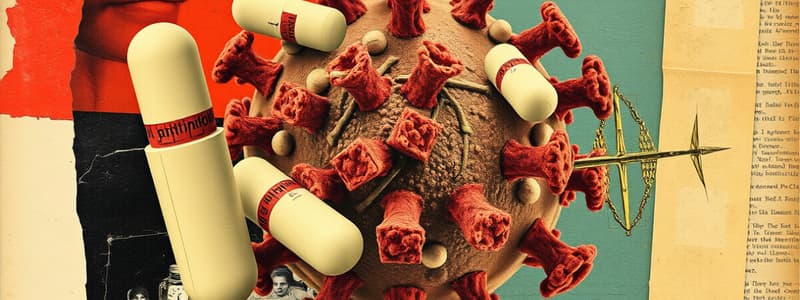Podcast
Questions and Answers
Which of the following antibiotics is classified as a 30S inhibitor?
Which of the following antibiotics is classified as a 30S inhibitor?
- Clindamycin
- Chloramphenicol
- Tetracycline (correct)
- Erythromycin
What is the primary action mechanism of aminoglycosides?
What is the primary action mechanism of aminoglycosides?
- Inhibition of DNA replication
- Inhibition of cell wall synthesis
- Concentration dependent killing (correct)
- Inhibition of folate synthesis
Which of the following antibiotics is NOT a 50S ribosomal subunit inhibitor?
Which of the following antibiotics is NOT a 50S ribosomal subunit inhibitor?
- Linezolid
- Chloramphenicol
- Erythromycin
- Vancomycin (correct)
Aminoglycosides are often administered in a single injection for the entire daily dose mainly due to what characteristic?
Aminoglycosides are often administered in a single injection for the entire daily dose mainly due to what characteristic?
Which of the following agents is a bactericidal antibiotic?
Which of the following agents is a bactericidal antibiotic?
What is the nature of the killing effect of chloramphenicol?
What is the nature of the killing effect of chloramphenicol?
Aminoglycosides are sometimes combined with which of the following to enhance their effect?
Aminoglycosides are sometimes combined with which of the following to enhance their effect?
Which of the following is a characteristic unique to aminoglycosides?
Which of the following is a characteristic unique to aminoglycosides?
Which of the following drugs are classified as macrolides?
Which of the following drugs are classified as macrolides?
What is a common adverse reaction associated with erythromycin?
What is a common adverse reaction associated with erythromycin?
What effect does impaired absorption of certain antibiotics have on children?
What effect does impaired absorption of certain antibiotics have on children?
Which of the following is a side effect linked to hepatic function impairment from antibiotic use?
Which of the following is a side effect linked to hepatic function impairment from antibiotic use?
What is a significant consequence of using certain antibiotics during pregnancy?
What is a significant consequence of using certain antibiotics during pregnancy?
Which of the following antibiotics is NOT classified as a GNAT?
Which of the following antibiotics is NOT classified as a GNAT?
What type of inhibition is associated with GNATS?
What type of inhibition is associated with GNATS?
Which of the following is a potential adverse effect of GNATS?
Which of the following is a potential adverse effect of GNATS?
Which mechanism of action describes how GNATS interfere with protein synthesis?
Which mechanism of action describes how GNATS interfere with protein synthesis?
Which statement best describes the effect of GNATS on mRNA?
Which statement best describes the effect of GNATS on mRNA?
Which of the following best explains the term 'bactericidal' in the context of GNATS?
Which of the following best explains the term 'bactericidal' in the context of GNATS?
What happens to polysomes when GNATS inhibit protein synthesis?
What happens to polysomes when GNATS inhibit protein synthesis?
Which of the following is an example of a 30S ribosomal subunit inhibitor?
Which of the following is an example of a 30S ribosomal subunit inhibitor?
What type of blockade can GNATS cause as an adverse effect?
What type of blockade can GNATS cause as an adverse effect?
In terms of ribosomal function, what is a key distinction between the 30S and 50S subunits?
In terms of ribosomal function, what is a key distinction between the 30S and 50S subunits?
What is one of the mechanisms by which bacteria develop resistance to aminoglycosides?
What is one of the mechanisms by which bacteria develop resistance to aminoglycosides?
Which of the following statements correctly describes the entry mechanism of aminoglycosides into prokaryotic cells?
Which of the following statements correctly describes the entry mechanism of aminoglycosides into prokaryotic cells?
How are aminoglycosides typically administered to ensure proper absorption?
How are aminoglycosides typically administered to ensure proper absorption?
What is the target ribosomal subunit of aminoglycosides in prokaryotic cells?
What is the target ribosomal subunit of aminoglycosides in prokaryotic cells?
What is the recommended dosing schedule for aminoglycosides based on their pharmacokinetics?
What is the recommended dosing schedule for aminoglycosides based on their pharmacokinetics?
Which of the following is true about the half-life of aminoglycosides?
Which of the following is true about the half-life of aminoglycosides?
Which type of bacteria is specifically targeted by aminoglycosides?
Which type of bacteria is specifically targeted by aminoglycosides?
What can result from mutations in the receptor protein of the 30S ribosomal subunit?
What can result from mutations in the receptor protein of the 30S ribosomal subunit?
What is the primary mechanism of action for macrolides?
What is the primary mechanism of action for macrolides?
Why are aminoglycosides not typically given orally?
Why are aminoglycosides not typically given orally?
Which of the following bacteria are macrolides effective against?
Which of the following bacteria are macrolides effective against?
Which phrase best describes the actions of aminoglycosides upon bacterial ribosomes?
Which phrase best describes the actions of aminoglycosides upon bacterial ribosomes?
What effect does increased metabolization by cytochrome P450 enzymes have?
What effect does increased metabolization by cytochrome P450 enzymes have?
Which of the following describes the spectrum of activity of macrolides?
Which of the following describes the spectrum of activity of macrolides?
Which of the following is an example of a clinical use for clarithromycin?
Which of the following is an example of a clinical use for clarithromycin?
How does the binding of macrolides to peptidyl transferase center affect protein synthesis?
How does the binding of macrolides to peptidyl transferase center affect protein synthesis?
What is the effect of improved acid stability of clarithromycin?
What is the effect of improved acid stability of clarithromycin?
Which bacterium is NOT typically treated with macrolides?
Which bacterium is NOT typically treated with macrolides?
What is the primary effect of metabolite inhibition of cytochrome P450 enzymes?
What is the primary effect of metabolite inhibition of cytochrome P450 enzymes?
Which of the following microbes can be treated with macrolides?
Which of the following microbes can be treated with macrolides?
Flashcards are hidden until you start studying
Study Notes
Protein Synthesis Inhibitors Overview
- 30S Inhibitors: Inhibit bacterial protein synthesis, including aminoglycosides (bactericidal).
- 50S Inhibitors: Include macrolides, clindamycin, and chloramphenicol, mostly bacteriostatic.
Aminoglycosides
- Typically administered as a single intramuscular or intravenous injection to optimize pharmacological effects.
- Exhibit concentration-dependent killing, resulting in faster bacterial elimination at higher doses.
- Possess a post-antibiotic effect, indicating prolonged antibacterial activity after drug concentration decreases below measurable levels.
- Often combined with cell-wall inhibitors (e.g., beta-lactams, vancomycin) for enhanced synergistic efficacy.
- Example drugs: Gentamicin, Neomycin, Amikacin, Tobramycin, Streptomycin (GNATS).
Mechanism of Action
- Bind irreversibly to the 30S ribosomal subunit:
- Interfere with initiation complex formation.
- Cause misreading of mRNA, producing nonfunctional proteins.
- Break up polysomes into inactive monosomes.
Pharmacokinetics
- Poor gastrointestinal absorption; administered via IV infusion typically lasting 30-60 minutes.
- Traditional dosing involves 2-3 equally divided doses per day.
- Half-life of 2-3 hours; some cases (e.g., TB treatment) require intramuscular delivery.
Adverse Effects
- Nephrotoxicity: Damage to kidneys.
- Ototoxicity: Potential for hearing loss.
- Neuromuscular blockade: Risk of muscle paralysis.
- Teratogen: Risks during pregnancy.
Mechanism of Resistance
- Transferase enzyme production leading to aminoglycoside inactivation.
- Mutations in porin proteins preventing antibiotic entry.
- Alterations in the 30S ribosomal subunit’s receptor proteins that inhibit binding.
Macrolides
- Characterized by the suffix "-thromycin"; examples include erythromycin, clarithromycin, and azithromycin.
- Primarily bacteriostatic, inhibiting protein synthesis via binding to the 50S subunit.
- Known adverse reactions include gastrointestinal upset (nausea, anorexia, diarrhea) and potential hepatotoxicity (acute cholestatic hepatitis).
Spectrum of Activity
- Effective against various pathogens, including:
- Gram Positive: Streptococci, Staphylococci, Pneumococci, Corynebacteria.
- Gram Negative: Neisseria, Bordetella pertussis, H. influenzae.
- Atypical Bacteria: Mycoplasma, Bartonella spp.
Summary Notes
- Dosing for aminoglycosides leverages unique pharmacological properties to minimize toxicity while maximizing efficacy.
- Resistance mechanisms highlight a need for monitoring and adapting treatment strategies in bacterial infections.
- Adverse reactions necessitate careful patient selection and monitoring to mitigate risks in clinical settings.
Studying That Suits You
Use AI to generate personalized quizzes and flashcards to suit your learning preferences.





